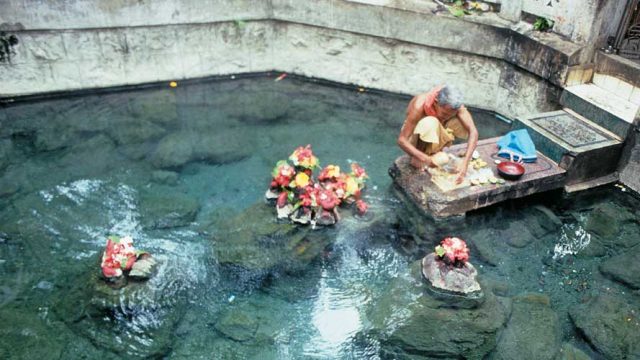One of the many marvels of nature, hot springs are generally said to be endowed with curative properties. Taptapani is actually a hot spring, and according to local folklore, has been around for more than 300 years. Worshipped by the tribals as Kandhuni Devi, Taptapani gets crowded during Sankrantis and festivals like Dussehra when people from the tribal villages nearby flock to worship the goddess. But the rest of the year, it is deserted, and if you love nature and serenity, this is just the place for you. Except for the call of birds, gurgling of mountain streams and the occasional sound of a motor vehicle passing by, it is absolutely quiet, affording that magical feeling of being completely cut off.
To get a real feel of Taptapani, stay at least two days, making it the base for your trips to Chandragiri.
THING TO SEE AND DO
The best thing to do in Taptapani is to rest and relax. Soak in the warm sun, breathe the fresh mountain air and feel one with nature. Sit in the wide verandahs or balconies of the guesthouse and just watch nature. At night, only jungle sounds prevail.
You can also take a long walk on the winding hill road, or climb up to see the source of a mountain stream. Visit the Saora tribal villages nearby with a staffer from the guesthouse who can guide you. Spend some time at the deer park – a large enclosure with deer, sambar and black buck maintained by the forest department.

The temple complex comprises of hot springs, enclosed as a circular tank. There are a few boulders inside, smeared with turmeric and sindoor, covered with dark red hibiscus – the special flowers offered to goddesses.
The goddess Kandhuni Devi is essentially a deity revered by the tribals. Worshipped in the form of stones from under which the hot springs emerge, she is believed to grant children. According to custom, women who seek her blessings keep a fast and worship the goddess. After taking prasad, they take a dip in the hot springs, and scoop out a handful of mud from the spring. The priest, locally known as Jani, takes a look at the mud and divines whether their wishes will be fulfilled or not. It is also believed that the waters contain medicinal properties and hence people suffering from skin ailments come here for a cure.
Farmers in this area take pots of water from the hot springs and sprinkle it all over their fields with the belief that the goddess will bless them with rich harvests. All rituals of Lord Nilakantheswara, the presiding deity of the Shiva temple near the hot springs, are also conducted with this water.

This perennial spring serves as the lifeline of the people, and never goes dry, not at the height of summer when water bodies in the neighboring areas shrink in size. However, according to some elderly residents the only noticeable change is that the sulphur content has reduced. According to folklore, the hot spring was earlier located in another spot, about 2 km away in a place deep in the forests called Belagada. But that spring gradually shrunk and water stopped flowing. Then the goddess appeared in the dreams of the priest and directed him to locate the spring in its present location. The ruins of the earlier hot springs, in the form of broken walls of the small tank are still visible.
Warm water from the main tank flows to a couple of larger tanks, and there are separate bathing enclosures for men and women. A small pathway leads to a Shiva temple a few steps away and the whole area is shaded by large trees, their rounded trunks looking like pillars. An old corrugated tin-roofed structure to the left of the entrance arch serves as a dormitory. A few stray dogs lazing nearby complete the rustic ambience of the location.

WHERE TO STAY AND EAT
The Panthanivas (Tel: 06816-255031, Cell: 09778831172; Tariff: ₹1,000-3,500, tree house ₹2,750) run by the Odisha Tourism Development Corporation is the best option here. The large deluxe suites are excellent options and great value for money if you want to enjoy the warm soothing water of Taptapani hot springs, right in the privacy of your room. Water from the hot springs is directly piped to the bathrooms of all rooms here. It is advisable to book in advance during tourist peak season, that is October-February.
The restaurant in Panthanivas is quite decent. It serves Chinese, Indian and Continental dishes, but the menu is restricted to the available stock of vegetables and groceries. Fresh fish and country chicken are the specialities here and are highly recommended.
TIP If you have children travelling with you carry some dry snacks and bottled drinks for them. Be armed with mosquito repellents/ creams as this is a malaria-prone area. Also, ensure that you are carrying your medicines as there are no chemists in the vicinity. During winter, carry warm clothes as the nights tend to get very cold.
When to go October to April is the best. Avoid the monsoons as they tend to be very heavy and the roads are likely to be in a bad state Location Set amid thick forests and hills, the hilltop Taptapani is in the Eastern Ghats, Air Nearest airport: Bhubaneswar Rail Nearest rail: Behrampur
THE INFORMATION |
Tourist/ Wildlife Offices Department of Tourism Govt of Odisha, Paryatan Bhawan Lewis Road, Bhubaneswar Tel: 0674-2432177 W orissatourism.gov.in |
Tourist Office 2nd Floor, Paryatan Bhawan Lewis Road, Bhubaneswar Tel: 2431299 |
OTDC Central Reservation Counter Pathanivas (Old Block) Lewis Road, Bhubaneswar Tel: 0674-2430764 W pathanivas.com |
Odisha Tourism Utkalika B/4, Baba Kharak Singh Marg, New Delhi Tel: 011-23364580 |
Tourist Office Govt of Odisha Adjacent to Pathanivas Buxi Bazaar, Cuttack Tel: 0671-2305225 |
Odisha Tourism At & PO Hill Patna Post Office Opp NCC Office Berhampur Tel: 0680-2222980 |
Odisha Tourism Pathanivas Building Police Line Balasore Tel: 06782-262048 |




